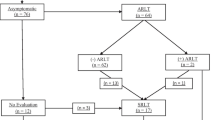Abstract
Background
Routine contrast esophagram has been shown to be increasingly limited in diagnosing anastomotic leaks after esophagectomy.
Methods
Patients undergoing esophagectomy from 2013 to 2014 at Huai’an First Peoples’ Hospital were identified. We retrospectively analyzed patients who underwent routine contrast esophagram on postoperative day 7 (range 6–10) to preclude anastomotic leaks after esophagectomy.
Results
In 846 patients who underwent esophagectomy, a cervical anastomosis was performed in 286 patients and an intrathoracic anastomosis in 560 patients. There were 57 (6.73%) cases with anastomotic leaks, including cervical leaks in 36 and intrathoracic leaks in 21 patients. In the cervical anastomotic leak patients, 13 were diagnosed by early local clinical symptoms and 23 underwent routine contrast esophagram. There were 7 (30.4%) true-positive, 11 (47.8%) false-negative, and five (21.8%) equivocal cases. In the intrathoracic anastomotic leak patients, four (19%) were diagnosed by clinical symptoms, 16 (76.2%) were true positives, and one (4.8%) was a false negative. Aspiration occurred in five patients with cervical anastomoses and in eight patients with intrathoracic anastomoses; aspiration pneumonitis did not occur in these cases.
Conclusions
Gastrografin and barium are safe contrast agents to use in post-esophagectomy contrast esophagram. Because of the low sensitivity in detecting cervical anastomotic leaks, routine contrast esophagram is not advised. For patients with intrathoracic anastomoses, it is still an effective method for detecting anastomotic leaks.


Similar content being viewed by others
References
Boone J, Rinkes IB, van Leeuwen M, van Hillegersberg R (2008) Diagnostic value of routine aqueous contrast swallow examination after oesophagectomy for detecting leakage of the cervical oesophagogastric anastomosis. ANZ J Surg 78(9):784–790
Honing J, Pultrum BB, van der Jagt EJ, Groen H, Plukker JT (2009) Routine or on demand radiological contrast examination in the diagnosis of anastomotic leakage after esophagectomy. J Surg Oncol 100(8):699–702
Agha FP, Orringer MB, Amendola MA (1985) Gastric interposition following transhiatal esophagectomy: radiographic evaluation. Gastrointest Radiol 10:17–24
Bains MS (1995) Ivor-Lewis esophagectomy. Chest Surg Clin North Am 5:515–526
Tirnaksiz MB, Tirnaksiz MB (2005) Effectiveness of screening aqueous contrast swallow in detecting clinically significant anastomotic leaks after esophagectomy. Eur Surg Res 37:123–128
Solomon DG, Sasaki CT, Salem RR (2012) An evaluation of the routine use of contrast radiography as a screening test for cervical anastomotic integrity after esophagectomy. Am J Surg 203(4):467–471
Markar SR (2013) Technical factors that affect anastomotic integrity following sophagectomy: systematic review and meta-analysis. Ann Surg Oncol 20:4274–4281
Jones CM, Heah R (2015) Should routine radiological assessment of anastomotic integrity be performed after oesophagectomy with cervical anastomosis? Best evidence topic (BET). Int J Surg 15:90–94
Shen Y, Wang H (2014) The effect of narrowed gastric conduits on anastomotic leakage following minimally invasive esophagectomy. Interact CardioVasc Thorac Surg 19:263–268
Alanezi K, Urschel JD (2004) Mortality secondary to esophageal anastomotic leak. Ann Thorac Cardiovasc Surg 10:71–75
Griffin SM, Lamb PJ, Dresner SM, Richardson DL, Hayes N (2001) Diagnosis and management of a mediastinal leak following radical oesophagectomy. Br J Surg 88(10):1346–1351
Zwischenberger JB, Sankar AB (1995) Transhiatal esophagectomy. Chest Surg Clin North Am 5:527–542
Cools-Lartigue J, Andalib A (2014) Routine contrast esophagram has minimal impact on the postoperative management of patients undergoing esophagectomy for esophageal cancer. Ann Surg Oncol 21:2573–2579
Dodds WJ, Stewart ET, Vlymen WJ (1982) Appropriate contrast media for evaluation of esophageal disruption. Radiology 144:439–441
Phillips LG, Cunningham J (1984) Esophageal perforation. Radiol Clin North Am 22:607–613
Wong J, Cheung H, Lui R, Fan YV, Smith A, Siu KF (1987) Esophagogastric anastomosis performed with a stapler: the occurrence of leakage and stricture. Surgery 101:408–415
Lowe L, Berkow AE (1978) Trauma to the esophagus. Gastrointest Radiol 2:305–321
Meyers MA, Ghahremani GG (1975) Complications of fiberoptic endoscopy. Esophagoscopy and gastroscopy. Radiology 115:293–300
Boone J, Rinkles IB (2008) Diagnostic value of routine aqueous cantrast swallow examination after oesophagectomy for detecting leakage of the cervical oesphagogastric anastomosis. ANZ J Surg 78:784–790
Siewert J, Stein H, Bartels H (2004) Anastomotic insufficiencies in the upper gastrointestinal tract. Chirurg 75:1063–1070
Oezcelik A, Banki F, Ayazi S et al (2010) Detection of gastric conduit ischemia or anastomotic breakdown after cervical esophagogastrostomy: the use of computed tomography scan versus early endoscopy. Surg Endosc 24:1948–1951
Schaible A, Ulrich A (2016) Role of endoscopy to predict a leak after esophagectomy. Langenbecks Arch Surg 401:805–812
Author information
Authors and Affiliations
Corresponding author
Rights and permissions
About this article
Cite this article
Hu, Z., Wang, X., An, X. et al. The Diagnostic Value of Routine Contrast Esophagram in Anastomotic Leaks After Esophagectomy. World J Surg 41, 2062–2067 (2017). https://doi.org/10.1007/s00268-017-3923-9
Published:
Issue Date:
DOI: https://doi.org/10.1007/s00268-017-3923-9




